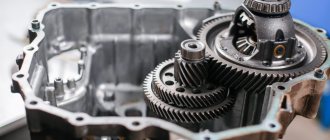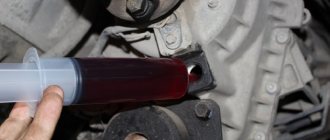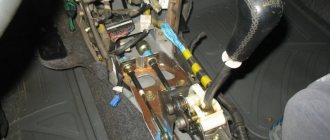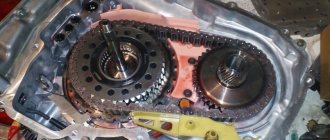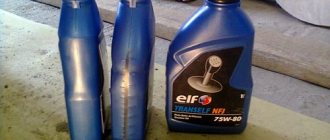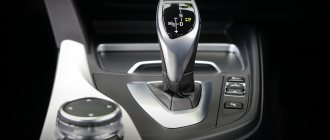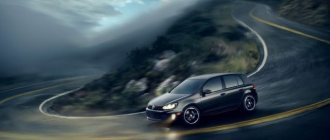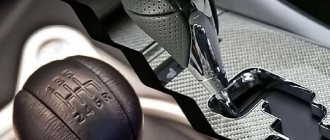23.09.2019
| (Votes: 2, Rating: 5) |
Issues discussed in the material:
- How does engine braking work?
- What are the pros and cons of such braking?
- How to brake with a manual engine
- Is engine braking possible on automatic and variator?
Reducing the speed of the car by pressing the brake pedal cannot always be considered the optimal solution. Experienced drivers use engine braking in some situations. However, to use this method, you must have certain skills. Incorrect actions can lead to accelerated wear of the motor and various breakdowns. In this article we will tell you in what situations it is worth using engine braking on cars with different designs.
How to brake correctly with manual brakes
To properly brake with a manual transmission before a traffic light, it is necessary to take into account both the characteristics of the vehicle, weather conditions, and the condition of the road surface. Let's assume you have to stop at a traffic light on a road with a smooth, dry asphalt surface.
We perform the following sequence of actions :
- The left foot presses the clutch.
- The left foot remains on the clutch pedal, the right foot presses the brake pedal.
These actions must be performed smoothly in order to prevent an abrupt stop, standing ten meters before the traffic light and not “catch a kiss” from the car behind. When the car comes to a complete stop, you must, while holding the clutch and brake depressed, engage first gear, which will allow you to immediately start moving when the permission signal lights up.
When should you use this braking method?
A correct assessment of the situation will allow the driver to determine whether it is possible to slow down in a particular case or not. Under certain conditions, performing engine braking is not only irrelevant, but also dangerous. Disputes often flare up among motorists over whether it is possible to brake with a manual engine, whether this is harmful to the unit and gearbox, and whether the use of the method is actually justified. There is an opinion that braking by reducing speed harms the engine, contributing to wear of the piston rings, and also negatively affects the gearbox synchronizers and other elements, and increases the level of oil consumption.
In reality, proper use of braking skills will not harm anyone's car. In addition, competent execution of the technique will allow you to avoid stress. It is also not advisable to use engine braking regularly; you need to look at the situation and not practice the method unless necessary. The use of the method is relevant under certain circumstances:
- In case of partial or complete failure of the brake system;
- On wet and slippery road surfaces for better traction;
- On long descents;
- On mountainous terrain, serpentines.
When the road is slippery, you need to work with the clutch very carefully, because if it is suddenly released, this may result in the drive wheels locking. It is recommended to hold the clutch pedal for a second at the moment of pickup. An important point is the braking distance - it, as well as the rapidity of the drop in speed, is important to take into account when performing the technique.
Braking in extreme weather conditions
Being able to slow down and stop on dry road surfaces with a manual or automatic transmission is not the most important thing. It is much more difficult for a novice driver to prevent skidding or skidding. The most important thing is to learn how to brake your car correctly in cold weather on slippery road surfaces.
How do you need to brake with a manual transmission and at the same time prevent skidding and skidding in icy conditions? First of all, you need to drive the car more calmly than in the summer on good and not wet asphalt.
On a wet or icy road or in snow, due to poor adhesion of the car wheel surface to the road surface, the braking distance increases several times.
Even if you have foreseen the worsening weather conditions and “changed” your car into winter “shoes”, be more careful, drive your car more smoothly, and start braking in advance. Remember: driving in the summer and in the cold season are two completely different styles of driving your car.
Use engine braking to properly stop a manual transmission on icy road surfaces. This method can be used not only in icy conditions. But first, let's understand what engine braking is and why it should only be used in limited driving situations.
How to properly turn off a diesel engine with a turbine and a gasoline turbo engine
If the power unit is equipped with a turbocharging system, then it is extremely undesirable to turn off such an engine immediately. This requirement applies to both diesel and gasoline cars. Moreover, the load mode on the internal combustion engine does not matter much.
Ignoring this rule leads not only to local overheating of the engine, but also to possible breakdowns of the turbocharger, a significant reduction in its service life, etc. The problem is that the turbine operates due to the flow of exhaust gases and gets very hot from contact with them. If you suddenly turn off the engine, the hot turbocharger will stop. As a result, the supply of engine oil, which lubricates and cools the turbine bearings, is completely stopped. The inertial rotation of the turbocharger after stopping the engine is sufficient for almost dry operation. It turns out that the temperature of the turbine increases greatly, and the turbine bearings are lubricated only by the residual oil in the turbocharger itself. Under the influence of high temperatures and loads, the residual oil cokes and the mechanical elements of the turbocharger suffer from wear.
We also recommend reading the article about the design of a diesel turbine. From this article you will learn about the operating principles and design features of a turbocharger on engines of this type.
Taking into account the above, turbo engines should be turned off only after the engine has been idling for 60 seconds to 2-3 minutes. During this time, the temperature of the turbine decreases, since the intensity and temperature of the exhaust gas flow at idle is minimal. It is recommended to turn off any car no earlier than ten seconds after the vehicle has come to a complete stop; this applies to any type of engine and car.
Features of engine braking
This type of braking can be used in a number of situations:
- It is necessary to stop or brake on a steep or long descent,
- The brake pedal has failed.
What does engine braking mean? In fact, this method should be called braking not by the engine, but by using the gear lever. Although, if we evaluate it in terms of the influence it has on the mechanisms of the machine, in this case the engine is mentioned here quite rightly.
To start engine braking, you need to release the accelerator pedal, then you need to alternately switch from higher speed gears to lower ones.
Please note : these actions must be performed one by one.
If you go from 5th gear directly to 1st, you will immediately lose control of your vehicle. In this case, the car will skid, and the engine may break. It will be a great success if on your way in this case there is a flat, clean field, and not an oncoming collision with rushing cars, or another equally dangerous obstacle.
Thanks for subscribing!
Pros and cons of the method
The advantages of engine braking are so great that they must be used, especially on long descents:
- if the same amount of energy as the engine is capable of receiving is released into the service brakes, then they will inevitably overheat and fail, but this will not harm the engine in any way;
- if the main braking system fails, deceleration with the help of the engine will remain the only way to save the car, passengers and everything that gets in the way of the faulty car;
- in mountainous conditions there are no other ways to safely descend; brakes capable of withstanding mountain conditions are not installed on civilian vehicles;
- when braking by the engine, the wheels continue to rotate, that is, they do not lock, and the car retains the ability to respond to the steering wheel, with the exception of extremely slippery surfaces when the tires will lose contact even with slight deceleration;
- with rear or all-wheel drive, the car is stabilized by the deceleration vector;
- The life of discs and pads is saved.
There are some downsides:
- the deceleration intensity is low, the difference between energy and power should be understood, the engine can absorb significant energy, but not in a short period of time, here the braking system is much more powerful;
- deceleration is difficult to control, the driver must have knowledge and skills, and automatic types of transmissions must include appropriate shifting algorithms;
- not all cars are trained to turn on brake lights during this type of braking;
- With front-wheel drive, sharp braking can destabilize the car and send it into a skid.
We can talk about the advantages and disadvantages only in terms of information; in fact, the mode is vital, without it the scope of use of the car is greatly limited.
Automatic engine braking
To use engine braking on an automatic transmission, you should pay attention to the advice of experienced drivers. There is nothing particularly complicated here. Before driving along a downhill road, you need to switch to the D3 downshift mode; for steeper descents, guided by your feelings, you can switch to the D2 (L) mode. To apply additional braking, use the Hold button.
Anti-lock braking system
Another discovery of the modern automotive industry is the anti-lock braking system ABS. When you press the brake pedal sharply, the car's wheels will not skid, but will remain under the control of the car computer.
Under normal road conditions, a vehicle equipped with ABS has a significantly reduced braking distance. Extreme situations, when the wheels of the car skid or slip, are minimized. A car equipped with an ABS system does not skid.
If your car has such a system, questions about proper braking with ABS are unnecessary, just start braking. At some points on a slippery road surface or in other difficult road conditions, the brake pedal begins to tremble and put pressure back on the driver's foot. There is no need to worry, the ABS system is working, continue to brake confidently.
A number of car models are now equipped with a button to turn off the ABS system. Sometimes seasoned car owners use this function. But even for them, we do not recommend turning off the system! If your car does not have such a button, but you still need to disable the ABS, then this can be easily done by removing the fuse responsible for its operation.
There is an opinion that the use of the ABS system leads to an increase in braking distance. This opinion will be correct only under the following conditions:
- The road surface is uneven and loose . For example, gravel or sandy surface, deep snow. Under such conditions, a car not equipped with ABS will most likely “burrow” and stop moving if the wheels are blocked. It is in such conditions that experienced motorists use the function of disabling the anti-lock braking system.
- “Bald” tires . Driving on such tires becomes much more dangerous in a car equipped with ABS.
ABS has a number of irrefutable advantages that make braking easier in difficult conditions:
- There is no need to make a series of quick and intermittent presses on the brake pedal - the ABS is activated with 1 long press
- The car remains under full control of the driver.
- Even sharp maneuvering at higher speeds is now possible, since the ABS braking system is more sensitive and confident.
Protection of the engine and turbine from overheating after shutdown
On specialized auto forums, many people are interested in why the fan is running when the engine is off. Also, new owners of turbo engines often raise the topic: “I can’t turn off the engine with the key.” To make it clear, most modern cars have standard protection. For example, if you immediately stop a hot engine, then:
- after stopping the internal combustion engine, the risk of local overheating of the CPG and other engine elements increases;
- if the air temperature outside is negative, then the hot engine will be affected by a sharp temperature change;
Both overheating and rapid uneven cooling can lead to damage to various parts of the unit (pistons, rings, cylinder head, etc.). For this reason, the engine cooling fan may run for some time after the engine is stopped, powered by the battery. This solution allows you to cool the engine, minimizing possible consequences.
As for turbocharged units, many cars have a so-called turbo timer. In simple words, this device allows you to automatically turn off the engine with a turbine after a specified period of time.
Otherwise, the engine will not stop immediately after the key is removed from the ignition. This solution is “insurance” in case the driver forgets to let the diesel engine or gasoline unit idle after driving. Also, installing a turbo timer allows the driver to immediately get out of the car and put it in security mode, without waiting for a certain time to cool the turbine. The main disadvantage can be considered the need to put the car on the “handbrake” on a car with a manual transmission, which can lead to freezing of the rear brake pads in winter after a long stay.
What to do if the brakes fail
- Warn other drivers! Signal and turn on your hazard lights
- At low speeds, it makes sense to use the handbrake. We press the button and smoothly lift the lever, while paying attention to the clicks, and do not allow sudden braking and blocking of the car wheels.
- Is handbrake braking impossible for some reason? Brake the engine! In critical conditions, it is necessary to turn off the ignition and turn on first gear. In this case, a breakdown of the gearbox or engine is guaranteed, but life is much more important.
- Can't stop? Then look for items that can serve as a deterrent. Damage from a collision with them should be minimal. Thickets of bushes, snowdrifts, and piles of garbage are suitable.
Regardless of what gearbox your car is equipped with or what road surface you are driving on, you first of all need to be firmly confident in your capabilities. That is why, before you get behind the wheel of a high-risk vehicle and drive onto a busy highway, you have to learn how to brake correctly.
What does engine braking mean?
The engine of the car is designed in such a way that it constantly tends to idle. By pressing the gas, the driver forces the engine to speed up, and after the driver releases the gas pedal, the speed is again minimized. For a car moving in gear, this means a reduction in actual driving speed. This is called engine braking. The ability to reduce speed without the participation of the braking system is a very important skill that allows you to eliminate the possibility of wheel locking when braking on a slippery road, as well as in case of malfunctions in the braking system to avoid an accident.


